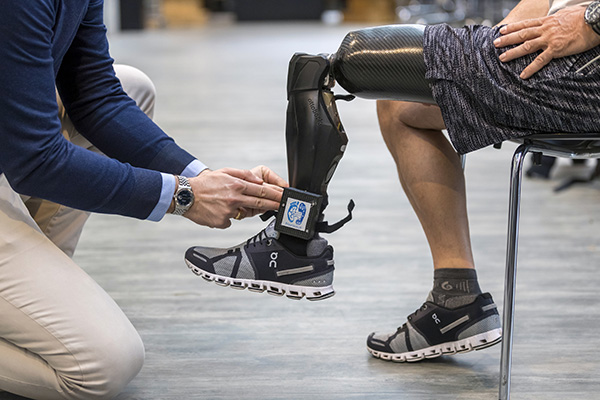Among the challenges facing people whose legs have been amputated above the knee is a lack of sensory feedback from most commercially available prostheses. Researchers at ETH Zurich recently found that artificial neural feedback from a sensorized bionic leg can help users as well as designers of robotic assistive technologies.
The scientists conducted their study at the Laboratory for Neuroengineering, which is part of the Department of Health Sciences and Technology's Institute for Robotics and Intelligent Systems at ETH Zurich. They said that sensory data can improve the quality of life and confidence of prosthetics users as they conduct everyday activities such as climbing stairs or walking over ground.
The team published its results this week in Science Advances. Dr. Giacomo Valle, a post-doctoral researcher of neuroengineering at the Swiss institute and lead author of the study, responded to the following questions from Robotics 24/7. He was named as one of the top 100 innovators under 30 by Forbes Italia.
Why has artificial neural feedback not been explored or developed until now? Is it too expensive or difficult, or have the human-machine interfaces reached maturity only recently?
Valle: In the past several years, neural sensory feedback has been explored by multiple research groups in the U.S. and Europe. The connection between brain and machine is fascinating but at the same time very complex, both at the neuroscientific and technological level.
Neural interfaces seem to be optimal technologies to communicate with the brain using neurostimulation, but they still have problems of stability for long-term applications. Moreover, the cost of a neuroprosthetic device is very high, as is the certification process to arrive on the market with an innovative neurotechnology.
How did connecting the human nervous system with robotic devices result in more natural movement?
Valle: The connection of the brain with the artificial leg re-establishes the flow of sensory information coming from the periphery. Indeed, after amputation, the brain is disconnected from the limb and excluded from the correct sensorimotor integration.
Restoring sensation of touch and proprioception in real time allows the user to improve his or her mobility, thanks to the reshaping of the kinematics in a more physiological walking. The processing of sensory information guarantees a better control of movements.
(All images and video are courtesy of ETH Zurich / Neuroengineering Lab.)
What is the sensation of the wearer of such sensorized bionic legs?
Valle: Thanks to the neural implants, the variety of artificial sensations elicited is very interesting. The patients reported sensations of touch, vibration, proprioception, tingling, etc. referred directly on the phantom limb, even 10 years after amputation.
The bionic leg is thus perceived more as part of the patient's own body, and patients experience a higher confidence while walking with the prosthesis.
Your report said that users expressed more confidence and reduced strain. In terms of performance improvement, did this technology help users climb faster or more safely?
Valle: Yes, indeed. The prosthetic users experienced multiple benefits from the sensory feedback restoration. We observed the following:
- Motor benefits, with increased mobility and agility due to the restoration of a more physiological walking
- Cognitive benefits, with a reduction of the perceived prosthesis weight and higher body and brain integration of the device
- Health benefits, thanks to the diminishment of “phantom limb” pain and its metabolic cost while they walk
What sorts of patients are most suitable for this technique?
Valle: The patients with transfemoral amputation—amputation above knee—are more suitable for this technology since their level of disability in mobility, for example in climbing stairs, is quite severe.
We believe that this technology could improve the quality of life of people with a leg amputation.
How did the test subjects respond to these neuro-robotic devices?
Valle: Although there were some individual differences, we observed similar beneficial results in all the three patients implanted with this sensorized neural prosthesis. Of course, testing with a larger pool of patients is necessary to generalize our findings.
The journal article showed a person on a bicycle—how does this enabled prosthesis help with that activity, in comparison with walking on uneven surfaces or stairs?
Valle: The prosthesis used in this study was a RheoKneeXC from Ossur that already has this function. Our system is usable in combination with different types of prosthetic device and can provide sensory feedback also when the patient is cycling. The patient can perceive the force applied on the pedal and the movement of the artificial leg.
What we are trying to evaluate is the benefit of such technology in the activities of daily life, such as driving a conventional car.
Can this sensory feedback be combined with hardware design for more ergonomic prosthetics?
Valle: Yes, it can be used with any type of commercial prosthetic devices. The tactile feedback is available in all the cases. The position feedback is connected to the flexion/extension of the prosthetic knee, so the joint must be present in the prosthetic device in order to be exploited.
Could these insights be applied to users of powered exoskeletons or power-assisted prosthetics?
Valle: This is exactly what we are now exploring in collaboration with other ETH labs expert in wearable exoskeletons. The fusion of neurotechnology and innovative robotics is the next frontier of rehabilitation.
What is next for making neuro-robotic prostheses commercially available?
Valle: There are several issues to be faced before arriving on the market. First, there's the stability of the implants. So we need to test the system for a longer period of time using not anymore percutaneous cables but a fully implantable system—like pacemakers—placed under the skin chronically. We are currently hardly working on that!
About the Author
Follow Robotics 24/7 on Linkedin
Article topics
Email Sign Up













